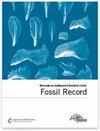Sabine Nürnberg, Martin Aberhan, Richard A. Krause
下载PDF
{"title":"Evolutionary and ecological patterns in body size, shape, and ornamentation in the Jurassic bivalve Chlamys (Chlamys) textoria (Schlotheim, 1820)","authors":"Sabine Nürnberg, Martin Aberhan, Richard A. Krause","doi":"10.1002/mmng.201200002","DOIUrl":null,"url":null,"abstract":"<p>Changes in body size have been the subject of numerous palaeontological and neontological studies, but despite several general postulated “rules”, the underlying processes controlling them are still incompletely understood, and their broad applicability is debated. Here we utilise morphological and ecological data from the Jurassic marine bivalve <i>Chlamys textoria</i> (Schlotheim, 1820) to analyse spatial and temporal trends in body size and ornamentation. We find: (1) fluctuations in body size during the Jurassic and no support for Cope's rule (the tendency to increase body size over geological time within an individual lineage); (2) a gradual increase in the average height to length ratio of the valves during the Jurassic. In the absence of any obvious adaptive advantage we suggest genetic drift as the causal mechanism; (3) a significantly larger mean body size in mid-palaeolatitudes than in the Jurassic tropics, providing evidence for the validity of Bergmann's rule (the assertion that body mass increases with latitude); and (4) a complex relationship between the number of plicae and the environment, which we explain as an improvement towards camouflaging the shell. (© 2012 WILEY-VCH Verlag GmbH & Co. KGaA, Weinheim)</p>","PeriodicalId":55147,"journal":{"name":"Fossil Record","volume":"15 1","pages":"27-39"},"PeriodicalIF":2.1000,"publicationDate":"2012-02-21","publicationTypes":"Journal Article","fieldsOfStudy":null,"isOpenAccess":false,"openAccessPdf":"https://sci-hub-pdf.com/10.1002/mmng.201200002","citationCount":"4","resultStr":null,"platform":"Semanticscholar","paperid":null,"PeriodicalName":"Fossil Record","FirstCategoryId":"89","ListUrlMain":"https://onlinelibrary.wiley.com/doi/10.1002/mmng.201200002","RegionNum":4,"RegionCategory":"地球科学","ArticlePicture":[],"TitleCN":null,"AbstractTextCN":null,"PMCID":null,"EPubDate":"","PubModel":"","JCR":"Q3","JCRName":"Earth and Planetary Sciences","Score":null,"Total":0}
引用次数: 4
引用
批量引用
Abstract
Changes in body size have been the subject of numerous palaeontological and neontological studies, but despite several general postulated “rules”, the underlying processes controlling them are still incompletely understood, and their broad applicability is debated. Here we utilise morphological and ecological data from the Jurassic marine bivalve Chlamys textoria (Schlotheim, 1820) to analyse spatial and temporal trends in body size and ornamentation. We find: (1) fluctuations in body size during the Jurassic and no support for Cope's rule (the tendency to increase body size over geological time within an individual lineage); (2) a gradual increase in the average height to length ratio of the valves during the Jurassic. In the absence of any obvious adaptive advantage we suggest genetic drift as the causal mechanism; (3) a significantly larger mean body size in mid-palaeolatitudes than in the Jurassic tropics, providing evidence for the validity of Bergmann's rule (the assertion that body mass increases with latitude); and (4) a complex relationship between the number of plicae and the environment, which we explain as an improvement towards camouflaging the shell. (© 2012 WILEY-VCH Verlag GmbH & Co. KGaA, Weinheim)
侏罗纪双壳类衣虫(Chlamys)体型、形状和纹饰的进化和生态模式(Schlotheim, 1820)
体型的变化一直是许多古生物学和新学研究的主题,但尽管有一些普遍假设的“规则”,控制它们的潜在过程仍然不完全清楚,它们的广泛适用性也存在争议。本文利用侏罗纪海洋双壳类Chlamys textoria (Schlotheim, 1820)的形态学和生态学数据分析了其体型和纹饰的时空变化趋势。我们发现:(1)侏罗纪时期的体型有波动,不支持柯普定律(个体谱系中体型随地质时间增加的趋势);(2)在侏罗纪时期,阀的平均高长比逐渐增加。在没有任何明显的适应优势的情况下,我们认为遗传漂变是原因机制;(3)中古高纬度地区的平均体型明显大于侏罗纪热带地区,为Bergmann规则(即体重随纬度增加)的有效性提供了证据;(4)壳的数量与环境之间的复杂关系,我们将其解释为对伪装壳的改进。(©2012 WILEY-VCH Verlag GmbH &KGaA公司,Weinheim)
本文章由计算机程序翻译,如有差异,请以英文原文为准。

 求助内容:
求助内容: 应助结果提醒方式:
应助结果提醒方式:


